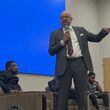Florida's Space Coast is owning up to its nickname as research and launch activity ramps up.
Feb. 6 was a historic day with the launch of SpaceX’s Falcon Heavy rocket.
The rocket successfully blasted off at 3:45 p.m., rescheduled from 2:20 p.m. and 1:30 p.m. due to winds. The boosters successfully landed simultaneously after the rocket launch.
It launched from 39A, the same pad used for the Apollo missions. SpaceX’s pad was damaged in September 2016 when a rocket exploded.
The Falcon Heavy rocket was a test launch, costing around $90 million. The heavy lift vehicle can place about 68.3 metric tons in low Earth orbit. The most a rocket has carried to orbit was the Saturn V at about 118 metric tons, used in the Apollo program in the 1960s and the Skylab space station in the 1970s. The most recent version of a single Falcon 9 rocket can lift 13.2 tons.
“If this is successful, this is once again SpaceX disrupting the marketplace and that's a good thing,” Dale Ketcham with Space Florida said before the launch.
SpaceX founder Elon Musk has played down expectations for the launch publicly, saying this is a brand new vehicle with 27 engines having to work in sync.
Large crowds were expected for the launch.
“We expect upwards of 100,000 people will come to the community just to see the launch, and that's on top of the people that are already here, including our seasonal guests, so it's going to be a huge crowd,” Eric Garvey of the Space Coast Office of Tourism said before the Tuesday launch.
Here are the main things to know about the Falcon Heavy liftoff:
- It is essentially three rockets bolted together to make the heavy vehicle.
- It is a test flight.
- The middle booster will carry Elon Musk's own Red Tesla Roadster.
- The Roadster is planned be near Mars' orbit in a precision Earth Mars elliptical orbit around the sun.
- The mission will try to prove that it is possible to put payloads into an orbit intersecting Mars. This would help in the mission planned to put humans in Mars.
- Musk presented this project in 2011 and he planned to roll out the heavy rocket in Southern California in late 2012. He hoped for a launch at some point in 2013 -- it was obviously delayed.
- The rockets were put in position in pad 39A and tested in December 2017.
- Falcon Heavy rockets cost a fraction of the price of the future Space Launch System rockets, which are planned to have more lift and throw a spacecraft further into space, to Jupiter and beyond. They will probably not be ready until the mid-2020s.
- Each rocket has nine engines, making it 27 engines in total that need to ignite in tandem.
- The two side rockets will jettison from the center rocket two and a half minutes after liftoff.
- The center booster will continue for a bit longer before engines are shut off.
- All three rockets are planned to land back on Earth; two back at the Cape and the heavier rocket at the Atlantic (barge) platform called "Of course, I still love you."
- There is a good chance that this launch may fail.
- Falcon Heavy weighs more than 3.1 million pounds (loaded with kerosene and liquid oxygen) and it's about 229 feet tall.
- If successful, there will be more heavy launches during the first half of 2018 from Cape Canaveral, too.
- Central Florida residents, especially those near the coast -- but as far away as metro Orlando -- may hear a sonic boom.





